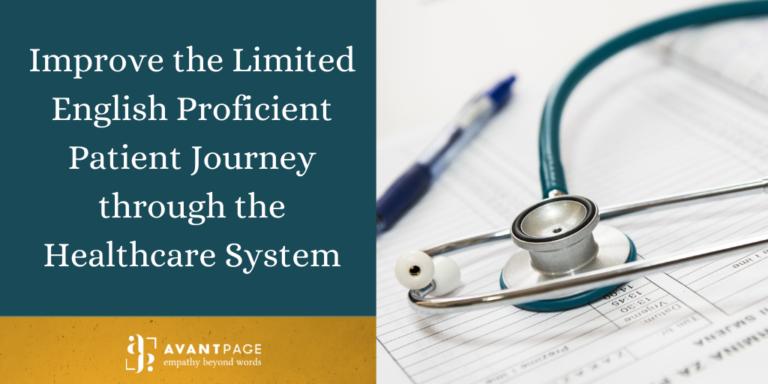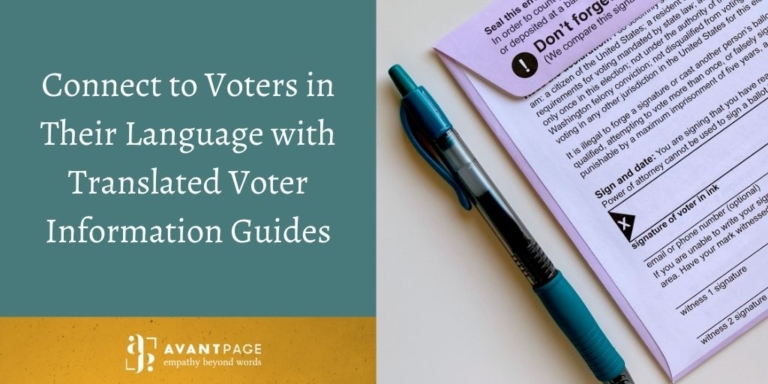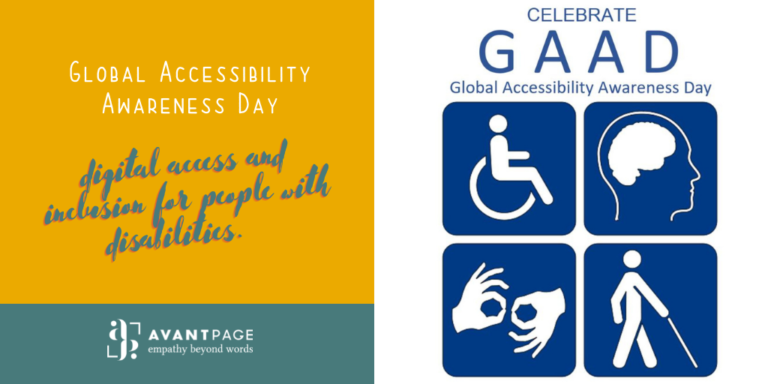Blogs

Improve the Limited English Proficient Patient Journey through the Healthcare System
By Joanna Oseman Let’s face it–navigating our healthcare system can be a challenge for anyone. From finding a provider to searching for the right form, it’s almost never a simple activity. Now imagine that you don’t speak or read English as you try to navigate through our healthcare system. Think about what a challenge that would be. With 25 million Americans speaking English less than very well, this scenario is unfortunately all too common. So what can be done about it? Healthcare providers have the opportunity to explore what it’s like for a Limited English Proficient (LEP) patient and their family to navigate their way by mapping out a patient journey and then exploring options to make improvements. A patient journey is a process of looking at the patient experience with a healthcare provider during each touchpoint in the process. It begins when a patient starts searching for a provider (pre-visit) to the appointment (visit) through after-care (post-visit). Going through the exercise of mapping out this journey can help providers see where there are gaps or areas that could use improvement, leading to better overall experiences and reducing inefficiencies. A patient journey for someone who’s a native English speaker is one type of experience. For those who aren’t native English speakers, that patient journey can look quite different due to the language barrier, both written and verbal. Let’s take a look at the LEP patient experience. Doing research online to find, validate, and evaluate healthcare providers is the way of the future. Check out these interesting statistics about the pre-visit step: What does this mean for healthcare providers? Think about the online (including mobile) pre-visit experience. What is that experience like for the LEP population? Can they easily find your business? Are they able to read about it in their language or is it English only? To attract more members, consider the following actions: The actual visit includes everything from finding the office (maps and signage), the check-in process (electronic or paper plus any COVID-related instructions), the appointment itself, and any necessary paperwork (educational resources, follow-up instructions, referral information, and more). What does this mean for healthcare providers? Consider each step of the appointment process, and evaluate the experience for the LEP population. The experience doesn’t end with the appointment. There might be follow-up appointments to make, calls with test results, care instructions, updates in patient portals, and more. What does this mean for healthcare providers? While the post-visit process varies for each individual, the same concepts that we mentioned earlier also apply here. At Avantpage, we provide a full suite of translation and interpretation services aimed at meeting the needs of immigrants and other LEP populations. One of our core industries is healthcare; we believe in promoting health through quality translation. We understand the LEP member journey, and we’re here to support you. We offer all the core services to enhance the LEP member journey, including localization and translation as well as interpretation, in over 150 languages. Visit our website to learn more about how we can help healthcare providers improve their customers’ experiences while also realizing process efficiencies. Read more about how healthcare organizations can support their LEP members in providing multilanguage support. For more information, contact us at [email protected] or (530) 750-2040. We’re here to support your LEP patients’ journeys.

Connect to Voters in Their Language with Translated Voter Information Guides
A special election for the recall of California Gov. Gavin Newsom is set for September 14, 2021. The last time this happened in California was in 2003 when Gov. Gray Davis was recalled and replaced by Arnold Schwarzenegger. When an election occurs, there are strict requirements for what and how content needs to be delivered to voters so that they can become informed and prepared to vote. The California Secretary of State’s elections office produces a statewide Voter Information Guide (VIG), which must be translated for LEP voters into nine threshold languages: Spanish, Chinese, Vietnamese, Tagalog, Korean, Khmer, Hindi, Thai, and Japanese. We were recently awarded the project of translating the Voter Information Guide for the upcoming recall election. What’s more, we also translated the VIG for the 2003 recall election. Since then, we’ve translated 14 VIGs for five primaries, six general elections, and three special elections (the 14th being the September 2021 special election). A lot has changed since 2003, but one thing that hasn’t changed is our ability to deliver the translated versions of the VIG, despite the challenges that come along with it each time. These challenges include very tight turnaround times, complex formatting, and word counts of around 150,000 English source words. Avantpage was formed to help immigrants and to work with local and state government agencies that serve them, so this type of work is right up our alley. As our chief executive officer, Luis Miguel, explained, “Our commitment to enable immigrants to participate in our democratic process remains as strong now as it was in 2003. We’re honored to be able to continue to serve our immigrant population.” In preparation for this special election, we’ll share what it takes to translate a VIG for the state of California, and we’ll also look back at how things have changed since that 2003 election. As the saying goes, it takes a village. And it definitely takes a village to translate a VIG into nine languages with a very tight turnaround time. Here’s an example: we translated the Voter Information Guide for the presidential election in November of 2020. This 112-page guide contained 66,400 words with 12 propositions, along with an accompanying TOPL (Text of Proposed Laws) publication of 96 pages and 69,300 words. We had 27 days to translate and format it into the nine required languages. To complete this project, we worked with: We worked around the clock to deliver this important document for our LEP voters. The actual translation of the content is just one part of the overall translation process. Proofing that content is another major step. Since the translated version must look identical to the English, this visual proofing is a critical, detailed-oriented, and time-consuming part of the process. Here are just a few examples of the types of things that we must proof: As you can see, the proofing step also takes a village of detail-oriented language experts to produce the final VIG for print. Back in 2003, when we worked on the special election VIG, we certainly didn’t have the team that we just described. In fact, our CEO, Luis, did the bulk of the work from his garage, along with two part-time UC Davis students doing project management and proofing, and one part-time bookkeeper. In 2003, just six languages were required. Fast-forward to today: we have 35 full-time employees, in three main offices, with dedicated areas of Operations, Business Development, People Operations, and Systems. We’ve grown from annual revenue of $500,000 to $5M today. And as we mentioned earlier, we’re now on our 14th VIG project with a total of nine languages. Luis stated, “The combination of people, process and technology to provide quality language services to CA government serving immigrants was the basis of our success then, and remains so today. We welcome the opportunity to serve our LEP population in this capacity.” As a company based in California providing government translation services, we understand what it takes to meet the requirements of the LEP population for elections. We can scale up our dedicated teams to accommodate these types of projects without affecting our other client work. How can we help you increase voter engagement? Reach out to us to learn more. We’re happy to provide you with a free quote.

Effects of COVID-19 on Limited English Proficiency Students.
In 2019, who would’ve thought that schools would shut down and move online? Like many institutions and businesses, the coronavirus gravely impacted the US educational system. School districts scrambled to make decisions with no precedent for the situation. Teachers, students, administrators, and parents scrambled to adjust to the evolving processes and methods of online school while balancing work, family needs, and health issues. It was enough of a challenge for those with access to broadband internet services, additional child support, and flexible working schedules. But for those with Limited English Proficiency (LEP), many families struggled with additional and fundamental challenges, including lack of technology, access challenges to healthcare and mental health resources, lack of accurately translated content for COVID-related topics, reduced or eliminated school food, and many others. Let’s look at just some of how the lack of language understanding has affected LEP students and their families during this unprecedented time. COVID-19 put technology at the forefront of education across the globe. From classes to meetings to after-school clubs, the internet played a critical part in communication. Yet many struggled with accessing the internet or having slow connections. According to an FCC report, approximately 19 million Americans, which is 6% of the population, lack access to broadband service at threshold speeds. People who live in rural areas are the most affected, with nearly one-fourth of the population lacking access. And although the numbers fare much better in densely populated areas, many people in urban districts have a high concentration of poor students that can’t afford a subscription service. The internet aside, many students didn’t have reliable or newer machines to access the internet. So when schools shut down, they scrambled to help students by providing Chromebooks or other devices. Unfortunately, as schools everywhere dealt with the same issue, manufacturers weren’t able to keep up with orders. Combined with trade restrictions, many schools weren’t able to provide devices in time for the school year to start in 2020. Five million laptops were in jeopardy of being delivered at the beginning of the 2020 school year. Many devices couldn’t support the newer technologies required for online learning. In addition, school-issued Chromebooks needed to be updated when connected to the building Wi-Fi in the school building. Since Chromebooks weren’t in the building, students experienced glitches due to the lack of updates. Knowing how to fix device problems wasn’t common, as just 12% of US residents who are foreign-born and speak a language besides English were found to be at higher levels of proficiency in solving problems in digital problems. In addition, almost 21% of US adults who speak a language other than English have no computer experience. Needless to say, all of the technological obstacles made online learning a challenge. Many LEP students have taken on additional responsibilities and faced new challenges during the pandemic. In addition to the technical issues we described, students may have new family responsibilities such as helping their siblings with online school and caring for grandparents or extended family members while their parents work. During the height of the pandemic, most Latinx, immigrants, and refugee individuals were listed as essential workers, so they had to continue working during the pandemic, leading to more potential for exposure to COVID-19. In fact, although immigrants comprise 14% of the population, nearly 1 in 6 frontline workers were immigrants. If individuals tested positive for COVID-19, hospitals minimized interpreters and wouldn’t allow visitors, leading to a frightening experience for both patients and families, and causing financial hardships. As a result of all these challenges, more pressure was placed on the other family members to keep the family going. Kids are generally wired to be social—not social distance and learn online. Many immigrants and LEP students don’t have access to healthcare, including mental health resources. Although schools pushed counselors and therapists to watch and listen for signs of depression and other mental health issues, with the language barrier, it was more challenging to spot signs right away. Many felt ill-equipped with the language barrier and were also faced with offending students with cultural differences. Although a lot of work has been done in the last few years, there can still be a stigma around getting help for mental health, especially within different cultures. Clearly, many challenges still lay ahead. As a trusted language service company providing a full spectrum of translation services for LEP students and their families in the educational system, we’ve witnessed these challenges. During this time, we’ve also seen many positive things that organizations, governments, non-profits, and individuals are doing to reach LEP students, from all types of donations to community outreach programs to better access to information. We see several opportunities to help this population. For example, there’s much to be done on many levels to strengthen language access and parent engagement beyond the students’ rights to education, more training and education around the use of communication styles and channels that are culturally appropriate and accessible for reaching families, and education around US educational systems and expectations to support immigrant families. Avantpage’s mission is to help our clients create a linguistic bridge connecting people, cultures, and communities through mutual understanding. Although we come from diverse backgrounds and cultures, we’re joined together by a common goal of empowering immigrant populations in the pursuit of the American dream. We provide language services for the education needs of LEP populations. Our language services include written translations of educational materials and remote interpreter services at both the state and local level. During the pandemic, our translation of the California COVID-19 website (https://covid19.ca.gov/) has provided served millions of Californians, and we’re proud to be bringing our expertise to a new partnership with the nation’s largest school district – Los Angeles USD. For more information, contact us at [email protected] or (530) 750-2040. Let us help you provide the best language services for your students.

Accessibility outside the digital world: examples of ADA compliance
By Mariana Salamanca Vázquez
The Americans with Disabilities Act (ADA) is meant to protect people with disabilities from discrimination while providing them with the necessary accommodations to live with equal opportunities. The law covers employment, public services and accommodations, private entity services, and telecommunications, among others. But what does an accessible street, workplace, or transport actually look like?
In a practical sense, the ADA asks for employers, governments, and other entities to provide reasonable accommodation for individuals with disabilities. Here are some examples:
Sometimes, physical accommodations aren’t enough, so the following could be needed: Are you an employer looking to improve accessibility for your team? Check out the Job Accommodation Network and their very useful list of different accommodations, categorized by disability, by limitation, by work-related function, or by topic. If you work in local government, healthcare, education, or another public or private entity, you might want to look into accessibility for your publications and web content. At Avantpage, we can provide you with guidance and ADA-compliance services. Contact us for a quote or more information. And remember, it’s not just about complying with the law: building a more accessible world will turn us into a more democratic and empathetic society. #digitalaccessibility #accessibilitymatters #accessibilityforall #localgovernment #advocacymatters Sources and helpful links: What Are Some Examples of Accommodations Under the ADA? | Murphy Law Group, LLC (phillyemploymentlawyer.com) Americans with Disabilities Act of 1990,AS AMENDED with ADA Amendments Act of 2008 25 years after the ADA, sidewalks still speak louder than words | MinnPost Are Your Curb Ramps ADA Compliant? – raSmith Accommodations | U.S. Department of Labor (dol.gov) The ADA and City Governments: Common Problems

Avantpage celebrates the Asian American Pacific Islander Heritage Month
The recognition of the Asian American Pacific Islander Heritage was introduced in 1977 but it was in 1992 that Congress passed Public Law 102-450 which designated May as Asian/Pacific American Heritage Month. Why the month of May? It was chosen by the Congress to commemorate the immigration of the first Japanese to the United States, and to mark the anniversary of the completion of the transcontinental railroad ad both events occurred in May. First Japanese immigrant in the U.S Manjiro is said to be the first Japanese immigrant, arriving in the U.S on May 7, 1843. According to the National Endowment of the Humanities, the 14 year-old boy and his crew were caught in a violent storm, then stranded on a desert island. Manjiro was rescued and adopted by American Capt. William Whitfield, who renamed him John Mung and brought him back to Massachusetts. First Transcontinental Railroad Is Completed The Western population boom following the California Gold Rush of 1849 drove the need for the transcontinental railroad. Its completion on May 10, 1869 helped the development of the American trade, business, and population. Most of the workers who laid the tracks were Chinese immigrants. It was said that the railroad also had psychological effect of bringing the country together. Why celebrating the Asian Pacific American community is important? The Asian population in U.S, which nearly doubled between 2000 and 2019, and is projected to surpass 46 million by 2060, making it the largest immigrant group in the country. The estimated number of Native Hawaiian and Other Pacific Islander residents in the U.S is smaller with 1.6 million. Together, they form a considerable group of individuals from the East, the Southeast, the Indian subcontinent and the Pacific Islands, the reality is they have distinct cultures, nationalities, languages, and histories. Asian Americans, Native Hawaiian, and Pacific Islanders (AA&NHOPIs) represent more than 56 ethnic groups and 100 languages and are extremely diverse in culture, language, and health needs. Despite being are one of the fastest growing groups in the U.S, 30.9 percent of Asian Americans are not fluent in English. In addition, AA&NHOPIs are socio-economically disadvantaged; they also experience health disparities, and language barriers that sometimes limit healthcare access. Our role as a language service provider (LSP) As a language service provider (LSP), we help our clients better serve their communities through our language services. We believe that by empowering immigrants and limited English proficient (LEP) speakers, they will make better educated decisions and will thrive as Americans. For over 25 years and to meet our clients’ unique needs, our language capabilities continue to grow, exceeding 150 languages. Below are Asian American Pacific Islander languages that we provide translation, localization, and interpreting services for based on their consistent demand.

Get involved! Today is the Global Accessibility Awareness Day
By María Fernanda Aguilera Villegas Nowadays we cannot deny that technology is an essential part of our lives. Sometimes we may take for granted our ability to make a quick Google search and get the information we want. But what happens when that information is there, but something is keeping us from efficiently getting it? More than 1 billion people worldwide have a disability, or an impairment and they are the ones who struggle the most with today’s digital products. But that shouldn’t be that way. Someone with a disability must be able to experience the same first-rate digital experiences, services, and content as any other user without disabilities. This is the key theme of the Global Accessibility Awareness Day (GAAD), a global event that puts the focus on digital access and inclusion for people with disabilities. The #GlobalAccessibilityAwarenessDay takes place every year on the third Thursday of May, and, according to the official website, the purpose “is to get everyone talking, thinking and learning about digital access and inclusion”. On this day, accessibility professionals, advocates, and people with disabilities encourage everyone to think about the impact of digital accessibility (or lack thereof). From Ottawa to Bangalore, local events are hosted, and professionals share their knowledge about digital accessibility. Sometimes, people with disabilities showcase how they use the web and digital products using assistive technologies. In other events, designers, developers, and usability professionals assist people in creating technology products, such as websites, software, or mobile apps, taking into consideration the needs of certain disabilities. The Global Accessibility Awareness Day came to be thanks to a blog post written by Los Angeles-based web developer Joe Devon on his WordPress blog MySQLTalk. Titled “CHALLENGE: Accessibility know-how needs to go mainstream with developers. NOW.”, the blog post talked about how accessibility is low on the priority list when creating a website and how there needed to be a shift on how it was being addressed. After seeing the post, Jennison Asuncion, an accessibility professional from Toronto, commented on Twitter that he was “all over [his] idea of a Global Accessibility Day” and contacted Joe. Together, they joined forces, and their extensive networks, to launch the event in May 2012. Since then, they have become big names in making the internet more accessible for everyone. How to participate in GAAD Want to participate and raise awareness? Here are some ideas on how to do it! Whichever way you decide to participate, remember that the ultimate goal is to make all websites around the worldwide net easy to access and simple to use for everyone, regardless of conditions. By joining forces, sharing, and caring, we will surely be able to achieve this goal! Sources Day of the Year – Global Accessibility Awareness Day Global Accessibility Awareness Day official website Global Accessibility Awareness Day’s Wikipedia article

How Avantpage Stays in Compliance During Translation
At Avantpage, we partner with health organizations around the country to improve patient care and health outcomes through translation and language access. Our national, state, and community health plans rely on us for data security. Keeping them in compliance and protecting personal health information (PHI) is our priority. That’s why, in 2019, our Systems Team developed a custom data anonymization tool that we call AvantShield. Using AvantShield protects member PHI during translation and allows organizations to safely reap the numerous benefits of translation memory (TM). Using a TM for your translation work means that Avantpage saves every segment of approved translation delivered to your team. Next time you request a project, the file is run through our TM system and any repeated or similar text is instantly identified. Reusing previously-translated segments saves time, increases consistency, and reduces cost. What is Translation Memory? In accordance with HIPAA regulations, Avantpage does not store PHI in our systems. But the kinds of files that typically contain PHI, such as member letters, are highly repetitive. This makes them great candidates for leveraging a TM. To exclude these files from a translation memory database would be a lost opportunity for process and cost optimization. This is where AvantShield comes in. AvantShield identifies the PHI contained within a file before it goes to our translation teams. Identified text is replaced by a tag that shows linguists the type of data that has been hidden. For example, a medical record number is replaced by @MRN@, the name of the member by @patient_name@, and so on. This greatly aids a translator by ensuring context is not lost during the masking phase. Once the macro has completed its task, the file is sent to translators through AvantFlow. After translated segments are approved by our editors and proofreaders, the text is exported to its original format (Word, Excel, etc.) for delivery to the client. During this final stage, the previously-masked PHI is restored by AvantShield so that the translated document contains the information needed for member communication. While this is similar to the process above, PHI destruction happens after projects are closed and submitted to the client. This is the point at which translations are saved in the translation memory. Before being saved for reuse, AvantShield is applied to identify PHI, this time for permanent removal. To preserve context for future reference, tags are used in the same way as above. The personal data removed during this stage cannot be restored and the translation memory is considered “clean” and ready for use. If you are working with multiple translation vendors, chances are they each have a translation memory. In order to maximize the use of these tools, it is recommended to consolidate the translation memories at regular intervals. Avantpage provides this monthly service to our national health plans, and data anonymization is an important part of the process. During the consolidation, AvantShield verifies that no PHI remains in any of the vendors’ databases. A clean, secure TM is returned to all vendors for use in the coming month. The primary reason to use AvantShield is to protect PHI. Our linguists are able to perform in-context, culturally-appropriate translations without ever viewing personal data. Before we created AvantShield, some of our clients chose to manually remove PHI from files before sharing with us. This is time-consuming, error-prone, and unnecessary. AvantShield helps you stay HIPAA compliant without losing time on manual tasks. With a clean translation memory, you continue to increase consistency, shorten delivery cycles, and save money, safe in the knowledge that your member data is 100% secure.

Language access is a critical civil right!
Why law firms should consider offering over-the-phone interpreting (OPI) and video remote interpreting (VRI). While English is often the language of choice in business affairs across the globe, it is not always the case for legal proceedings. According to the most recent survey, 25 million U.S residents are considered limited English proficient (LEP) speakers. For these individuals, language access is a civil right in and outside of courts. As Vanita Gupta, Principal Deputy Assistant Attorney General expressed: “Barriers to language access can interfere with the capacity of state courts to accurately evaluate the facts and fairly administer justice. And they can also place unfair and unconstitutional burdens on individuals. Without language services such as over-the-phone interpreting (OPI) and video remote interpreting (VRI), all involved participants can’t fully take part in the proceedings. But before heading to courts, law firms must overcome their own language barriers in order to accurately represent their clients. When do law firms require the assistance of interpreters?
What to look for in a language service provider? You need to use subject matter experts as interpreters. Your legal interpreting needs must be handled by qualified and certified interpreters who have experience in the legal industry. With over 25 years of providing language services, Avantpage offers round-the-clock, over-the-phone interpreting (OPI) and video remote interpreting (VRI). With fast connection times, and over 250 languages, our interpreters meet the following requirements: We can help you with your next legal interpreting needs. Contact us at 530-750-2040, [email protected], or request a free quote to get started today.

Celebrating ASL Day
Today, April 15th we observe the National ASL Day which is a great opportunity to celebrate and learn more about American Sign Language. On this day in 1817, the American School for the Deaf (ASD) opened in Hartford, Connecticut. There, teachers and students worked together and, by intermingling Native American Signs, French Sign Language, and even Martha’s Vineyard Sign Language, American Sign Language (ASL) was born. With time, more schools for the deaf were founded and ASL spread not only to those schools but to the world. ASL is used in the majority of Canada, all throughout the American continent, and has even expanded to Central Africa, West Africa, and Southeast Asia.
Have more ideas? Share them with your network and local organizations with the hashtag #ASLday.
Sources:
Day of the Year: ASL Day
Wikipedia: American Sign Language
National ASL Day Official Website
At Avantpage our experienced team can help guide you through the translation process and make it fast and easy. To find out more about our services call us at 530-750-2040 x11, or request a free quote.
From the desk of María Fernanda Aguilera Villegas, Project Manager at Avantpage.

Actions speak louder than words: Accessibility at Avantpage
According to the Centers for Disease Control and Prevention (CDC), 61 million adults in the USA live with a disability. This means that 26% of the society, 1 in 4 people, has some type of disability in areas such as mobility, cognition, independent living, deafness, vision, or self-care. Therefore, assuring that the content is accessible for these communities is not only a good practice, but it helps provide equal opportunities for all. Opportunity and empathy, the core values of Avantpage, drive us to make our contribution to the accessibility area and raise the awareness of the language access-related needs of this large community. Only in the past few years, we’ve led hundreds of projects that served language minorities with disabilities in the areas of healthcare, social & governmental services. By now, over 30% of our translation projects that were compliant with the Americans with Disabilities Act (ADA) were directed to Spanish-speaking communities, 20% to Russian speakers, and 20% to the Vietnamese community. We have also supported our clients with translation and accessibility requests into languages of lesser diffusion, such as Marshallese and Samoan, and it makes us proud to be able to deliver our services to even the smallest communities in the US. At Avantpage, we make a difference by assisting our clients in the accessibility needs of their target audiences. Our team takes part in specialized training and conferences related to accessibility topics in order to keep improving our processes and deepen our expertise in this subject. A big shoutout to our entire Avantpage team, especially to our Project Managers and Coordinators, for their hard work and for their commitment to our values: rigor, empathy, and opportunity, put into practice by assisting those in need. For more information on how accessibility impacts all of us, please refer to the Centers for Disease Control and Prevention website. From the desk of Joanna Olton-Galindo, Quality Process Coordinator at Avantpage.

Accessibility Everywhere: The Scope of the Americans with Disabilities Act
When we hear the word “accessibility”, especially within the localization industry, we tend to focus on accessible documents and web content. However, the Americans with Disabilities Act (ADA) covers more than websites and written publications. Here is a breakdown of the scope of the ADA regulation: First of all – what is considered a disability? The ADA defines the term “disability” as a physical or mental impairment that substantially limits one or more major life activities for an individual. The condition can be mild or severe, temporary or permanent. Under this definition, some examples of disabilities included in the ADA are deafness, blindness, intellectual disability, mobility impairment, ADHD, HIV, bipolar disorder, cancer, depressive disorder, schizophrenia, among other conditions. The ADA does not cover conditions that result in illegal activity or are considered anti-social, such as pedophilia, kleptomania, or exhibitionism. Gender identity and sexual orientation are no longer considered disorders and are therefore excluded from ADA protection. Now, the ADA covers persons with disabilities against discrimination through its five sections: This section of the law protects individuals with disabilities against discrimination in the workplace. The title guarantees equal employment opportunities and benefits for people with disabilities, under any employer with 15+ employees. This includes private entities, State and local governments, employment agencies, and labor unions. Title I is regulated and enforced by the U.S. Equal Employment Opportunity Commission. The second title prohibits discrimination based on disability by all public entities. This includes all programs and services offered by state and local governments, as well as public transportation and housing.
Title II is enforced by the U.S. Department of Justice, the U.S. Department of Transportation, and the Office of Fair Housing and Equal Opportunity. This section covers against discrimination in places of public accommodation, which include privately owned, leased, or operated facilities like hotels, restaurants, retail shops, doctor’s offices, private schools, movie theaters, and similar services. It also sets standards for accessibility when building commercial or privately owned facilities, and for businesses to communicate effectively with customers with disabilities.
Title III is enforced by the U.S. Department of Justice. The fourth title requires telephone and Internet companies to provide telecommunication systems that allow individuals with hearing or speech disabilities to communicate over the phone. This title led to the installation of public teletypewriter machines (TTY), as well as other Telecommunications Devices for the Deaf (TDD).
Title IV is regulated by the Federal Communication Commission. Finally, Title V contains a variety of provisions that relate to the ADA as a whole, like its relationship to other laws, a list of conditions that are not considered disabilities, among other factors. So now you know a little bit more of how the law can help us create a more accessible environment across all entities. You encounter and use ADA-compliant services, transport, files, websites, and many other resources every day: whether you benefit from accessibility directly or not, remember that it makes our society more democratic and inclusive for all of its members. Sources:
An Overview of the Americans With Disabilities Act | ADA National Network (adata.org)
Americans with Disabilities Act of 1990, AS AMENDED with ADA Amendments Act of 2008 From the desk of: Mariana Salamanca Vázquez, Project Manager at Avantpage.

How Wearable Data Improves Multilingual Member Care
Wearable technology is transforming the healthcare landscape. From fitness trackers to blood sugar monitors, wearables empower individuals to take more control over their health. Yet wearable data is equally valuable for healthcare providers and health insurers. They can use it to provide personalized recommendations and develop resources that target specific demographics—including limited English proficiency (LEP) speakers. Given that many commercial wearables allow users to choose their preferred language, they can be particularly useful for LEP speakers. They provide recommendations that a user may not receive otherwise, and the language data they generate can help improve health outcomes. That’s because wearable data can inform decisions on interpreting, website localization, and other healthcare translation needs. But before we dive into how wearable data can improve LEP patient care specifically, let’s take a look at the benefits for both healthcare providers and health insurers. Wearables offer a window into a patient’s behavior and lifestyle. More reliable than self-reporting for metrics such as daily activity, these devices help doctors develop personalized treatment plans. Yet wearable data not only improves individual patient care. Hospitals that use remote patient monitoring—including wearables—saw improvements across metrics such as hospital admission, readmission, patient satisfaction, operating costs, and more. Rising health insurance premiums pose a major barrier for U.S. residents who need access to healthcare. However, wearables can help reduce premiums by incentivizing members to improve their lifestyle. For example, Humana developed a platform that allows members to connect their wearables with the Go365® app, the company’s wellness and rewards program. LEP patients typically experience poorer health outcomes due, in part, to a lack of language support. Language preference data can help healthcare organizations determine which languages have the highest demand and how much they need to budget for interpreting and translation services. LEP speakers may need access to a remote interpreter to: In order to access patient portals, member portals, and other online resources, they may need to have the website translated into their preferred language. This is also true for office signage, patient forms, information about treatment options, and other print materials. However, the benefits of collecting language data go beyond assisting individual patients. It can also help organizations develop multilingual patient education. By combining language data with health trends across racial and ethnic groups, organizations can create public health campaigns and other types of outreach in multiple languages. With the purpose of improving outcomes for LEP patients, organizations must take information such as race, ethnicity, health trends, and language preferences into consideration. Using this data to provide multicultural and multilingual patient experiences is an essential part of providing more effective healthcare. If you need assistance with translation, website localization and/or interpreting, we recommend working with a language service provider (LSP) that specializes in healthcare. At Avantpage, we’ve worked with hospitals and clinics, health insurers, and other health organizations to provide the language support LEP speakers need. By analyzing data, we can make recommendations on language choices, content development, and more. Ready to discuss your multilingual project? Contact us today to get started.